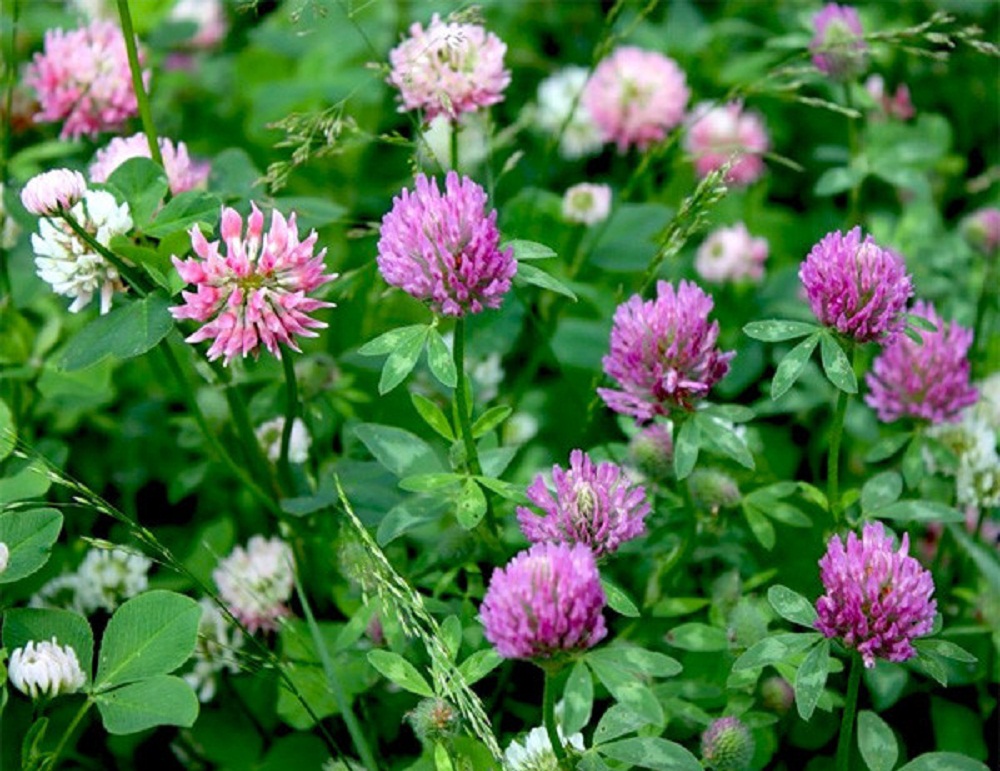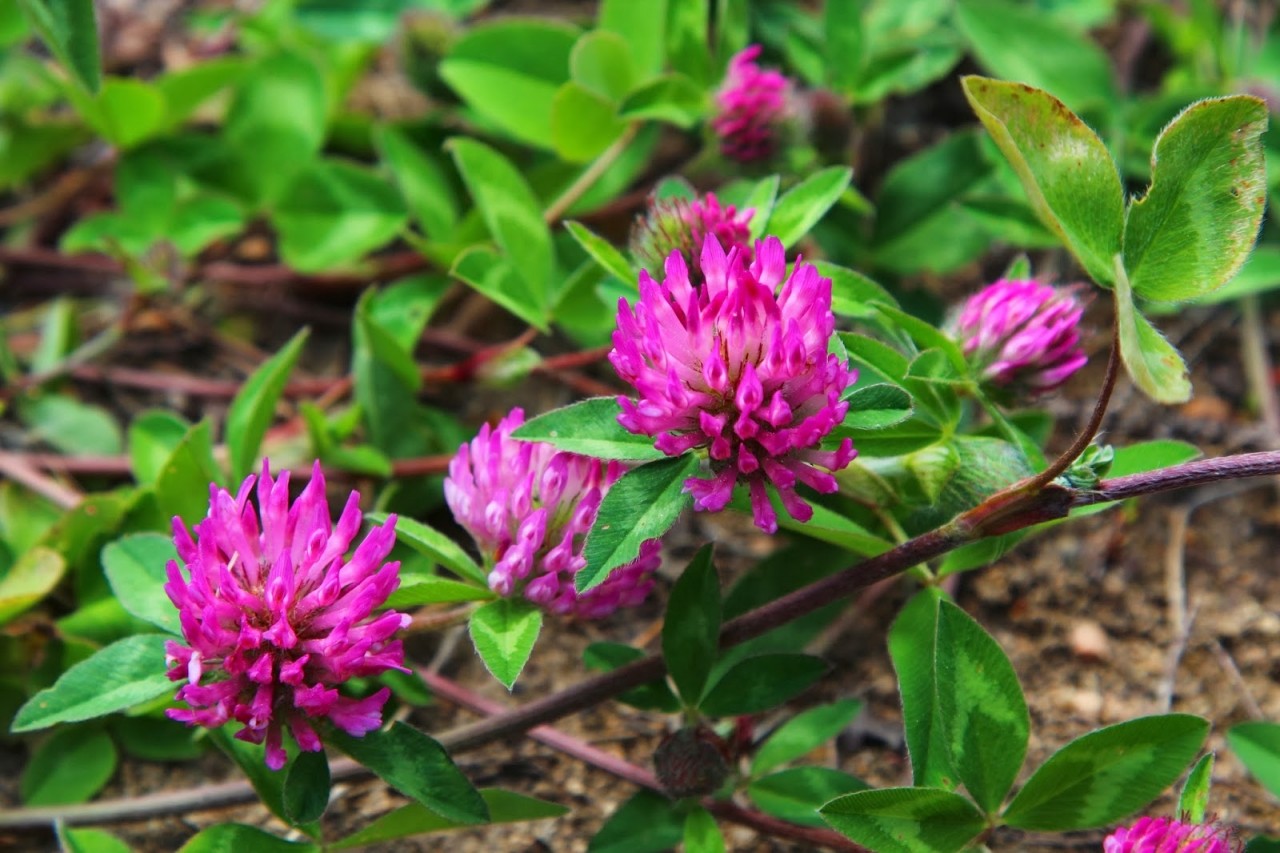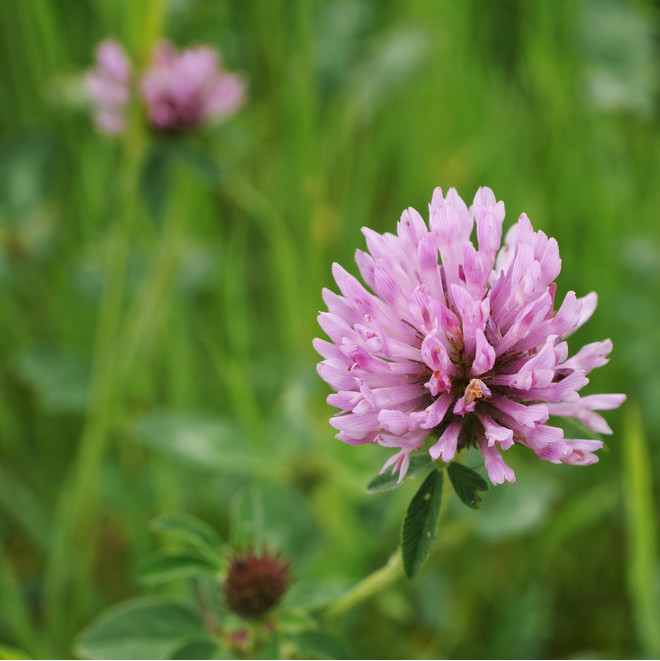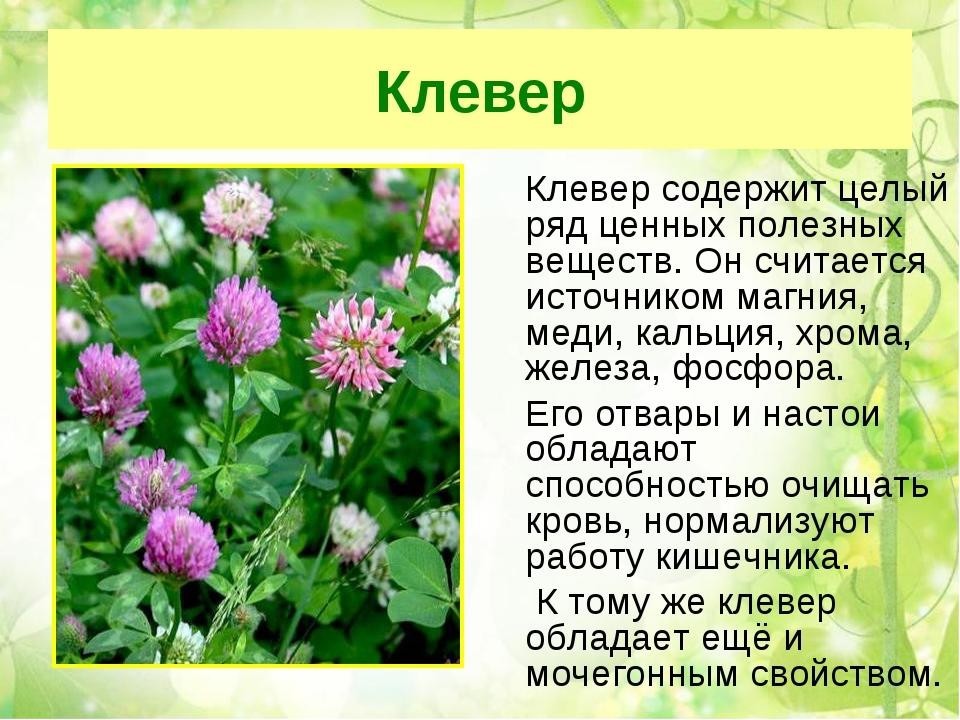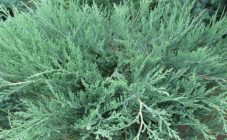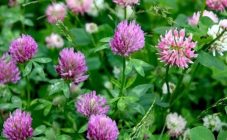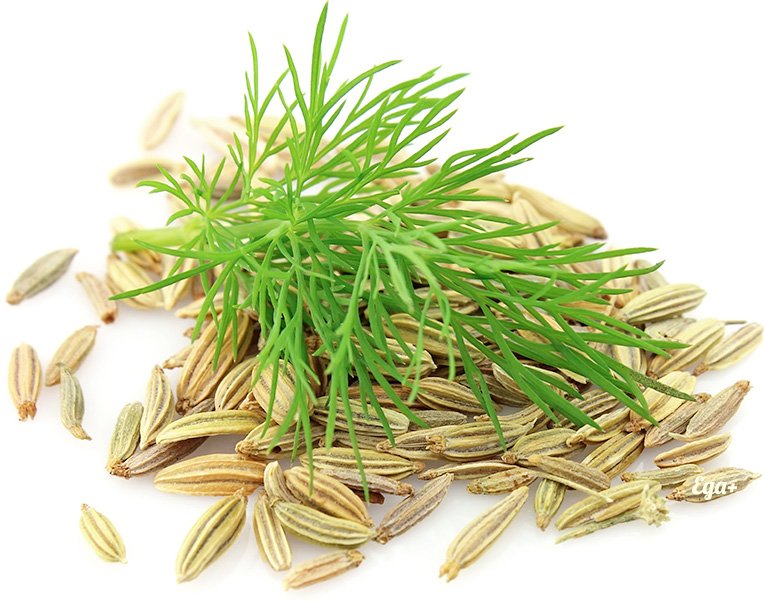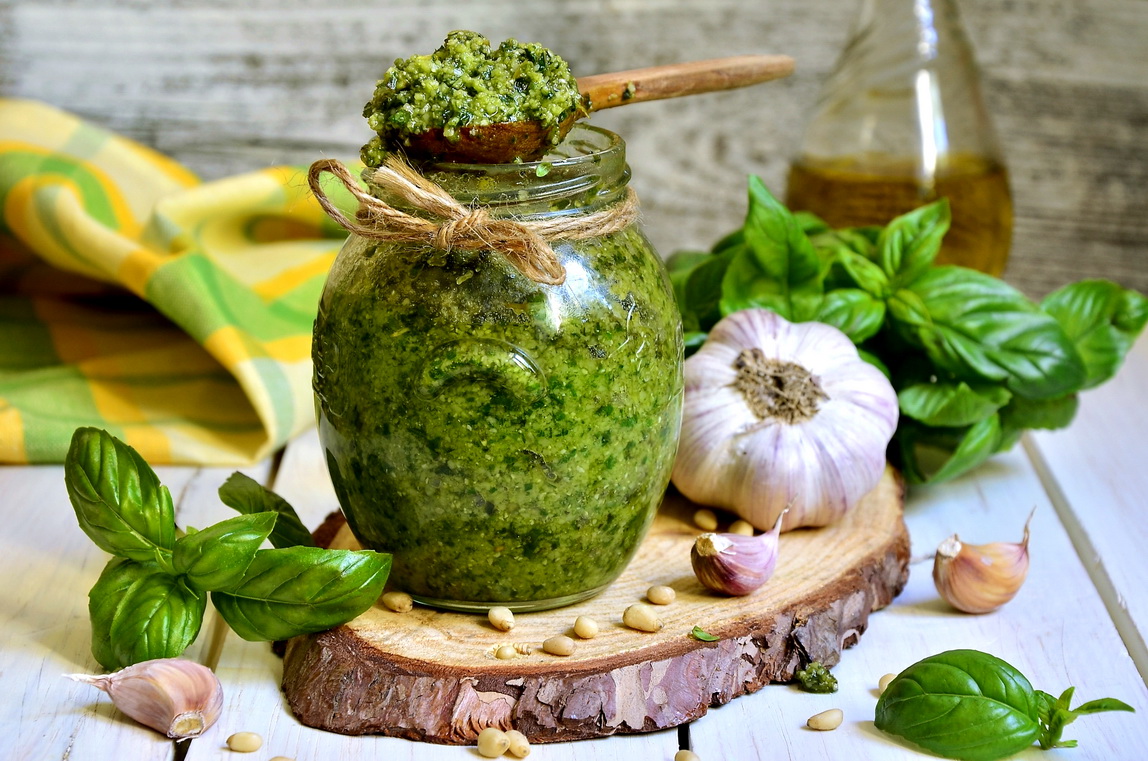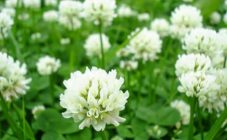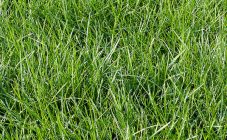Content:
Red clover belongs to the legume family and grows not only throughout Europe, but also in North African countries - Algeria, Tunisia, Morocco. It is often found in the Mediterranean, mountains of Western and Central Asia, in the European part of Russia, Western Siberia, in the Caucasus.
Description of meadow clover
Red clover (Trifolium pratense) grows in meadows and clearings, along roads and paths, mainly on moderately moist soil. Botanical properties are as follows: shade-tolerant and cold-resistant. It is a perennial plant whose seeds can germinate even at 2-3 ° C. It springs up in 5–8 days. There are varieties with a two-year life cycle. Plant height does not exceed 55 cm. The stems branch, rise from the ground. Lateral shoots grow from leaf sinuses. The leaves are trifoliate.
Red inflorescences of the head are spherical and formed from smaller flowers, often covered with upper leaves. Each clover flower has 10 stamens, of which 9 are fused, and one is spaced. The fruit is a single-seeded bean, ovoid. The seeds are different, round or angular in shape with a color ranging from yellow-red to purple. There is also a pistil, the stigma of which has a rounded shape. Ripening dates vary depending on the variety.
Many are interested in: is a clover a flower or a grass? This is a grass, but not simple, but an excellent green manure for improving the structure and quality of the soil.
A distinctive feature of meadow clover from other plants in the family is the presence of maakiain in its leaves, a flavonoid with fungicidal (antifungal) properties. This is an excellent green manure, when embedded in the soil, its structure improves, and the number of weeds is noticeably reduced. The soil is enriched with nitrogen, since when mowing the upper part of the plants, well-developed tap roots and lateral, adventitious roots remain, in which up to 150 kg / ha of nitrogen accumulates during the growing season. The flowers contain an essential oil (0.03%), which contains furfural, an aldehyde that smells like freshly baked rye bread.
Meadow clover varieties
Russian breeders have been constantly working to improve the properties of meadow clover. Currently, there are 2 types of it:
- winter - late ripening, one-cut;
- spring - early maturing, two-mowing.
Common clover can be propagated both by seed and vegetatively. The sowing rate is 16–20 kg / ha. Sown together with cereals, legumes or separately. All types of sown clover bloom for the first time only in the second or even third year. Life expectancy is different: from 2 to 10 years. Red clover sometimes has up to 25. But all depends on the variety and conditions. In meadows with natural crop rotation, once every 3-4 years there is a bountiful harvest of field clover, which subsequently decreases.
Due to its high agricultural value, many modern varieties have appeared. The following varieties were included in the State Register of Russia in 2013:
- Hephaestus is diploid, late ripening. Pubescence is weak or completely absent. With a lot of internodes.Medium leaf with white markings. Seeds are multicolor. Productivity is standard, expressed in dry matter as 50.4 c / ha. Recommended for the West Siberian region. Resistant to various diseases.
- Green - diploid, two-cut, has a characteristic friendly early flowering. The leaves are long, their width is medium, there are few white marks. The number of internodes is average. According to its properties, it is optimal for the Moscow region and the Volga-Vyatka region, especially for agricultural areas with low fertile and acidic soils. Susceptible to clover crayfish and anthracnose.
- The dragon is diploid. Early flowering, two-cut. The height of an adult plant varies. Depending on the weather, it can be quite short or quite tall. The bush is loose, the length and width of the leaves are different. The thickness of the stems is average, there is no pubescence. The yield, expressed in dry matter, is higher than the standard. Winter hardiness is normal. To a moderate extent it is affected by rust, anthracnose. Perfect for the Volga-Vyatka, Middle Volga and Ural regions.
Red clover is a very unpretentious plant. Prefers powerful and common chernozem, sandy loam, loamy, gray forest and sod-podzolic soils. However, if the humidity is insufficient, it sharply slows down its development. It also grows poorly on saline soils, the acidity of which is below 4.5 pH. It has high nutritional properties, it is planted for the purpose of further preparation of various feeds in animal husbandry, in which it is not inferior to alfalfa. Goes to harvest hay, silage, haylage.
The entire clover family is considered to be quite hardy plants, they rarely get sick. But they can be affected by some types of fungi, including flower mold, clover crayfish, anthracnose.
Useful properties of culture
Today, vitamin concentrates are made from the leaves of meadow clover, and essential oil is used as a component in the creation of modern fragrances. It is considered a valuable honey plant, but mainly pollinated by bumblebees. Bees can also get nectar, but only those with a longer proboscis than others. Therefore, the total honey productivity is only 6 kg / ha. The obtained honey is of high quality, it is not sugar-coated for a long time.
Even in ancient times, people used clover as a medicinal plant, as an anti-inflammatory and expectorant. With its help, they cleansed the blood and fought with severe pain. Doctor Avicenna knew exactly what clover helps from, used its freshly squeezed juice to heal wounds with scrofula, and tried to heal the kidneys with tincture of the plant in an alcohol solution. In folk medicine, it is used to fight metabolic disorders, lower cholesterol levels, and remove various toxic substances. They even increase the body's resistance to adverse conditions.
Isoflavones are found in red clover - plant substances that are partially similar in structure to the female hormone estrogen. That's what clover is good for! Not only the appearance of a woman depends on it: the beauty and health of the skin, hair, but also the state of health. The synthesis of estrogen decreases over time, the skin becomes dry and wrinkled, the hair thinns, the eyebrows begin to fall out. The body ages. Soybeans, red clover and flax seeds are used to maintain vitality. However, it is known that the content of phytoestrogens in clover is 20 times higher than in soybeans, 17 times higher than in flax seeds. If food contains a large amount of isoflavones, then the incidence of breast cancer in women decreases, and in men — prostate cancer. This healing effect is due to their positive effect on steroid hormones.
Dried and crushed clover flowers are used in cooking as a seasoning. And flour obtained from dry leaves is added to bread, thereby improving its composition and nutritional value. Such a product immediately goes into the dietary category.
Based on the latest scientific data and research conducted, we can conclude what exactly is the usefulness of red meadow clover for humans. But, nevertheless, despite such positive properties of clover as a medicinal plant, you cannot use it without first consulting your doctor. There are contraindications.
Interesting facts about clover
Four-leaf clover is a sign of good luck. Such a leaf is carefully dried and always kept with you in a special medallion. Previously, it was wrapped in a new piece of cloth or handkerchief.
Many people are sure that with the help of wild clover it is possible to remove the charms of failure and lack of money, and also not to become a victim of a love spell or evil eye, to get rid of diseases.
Despite all the valuable and medicinal properties of clover, it should be used in moderation for cooking. If taken for a long time in large quantities, it can cause menstrual irregularities (delay) in women and problems with potency in men.
So, having planted a clover on the site, the gardener will receive a medicine, remove weeds from the site and decorate the site with flowering flowers. Moreover, it will protect itself from the evil eye! What other plant in the world can boast of the same properties ?!
